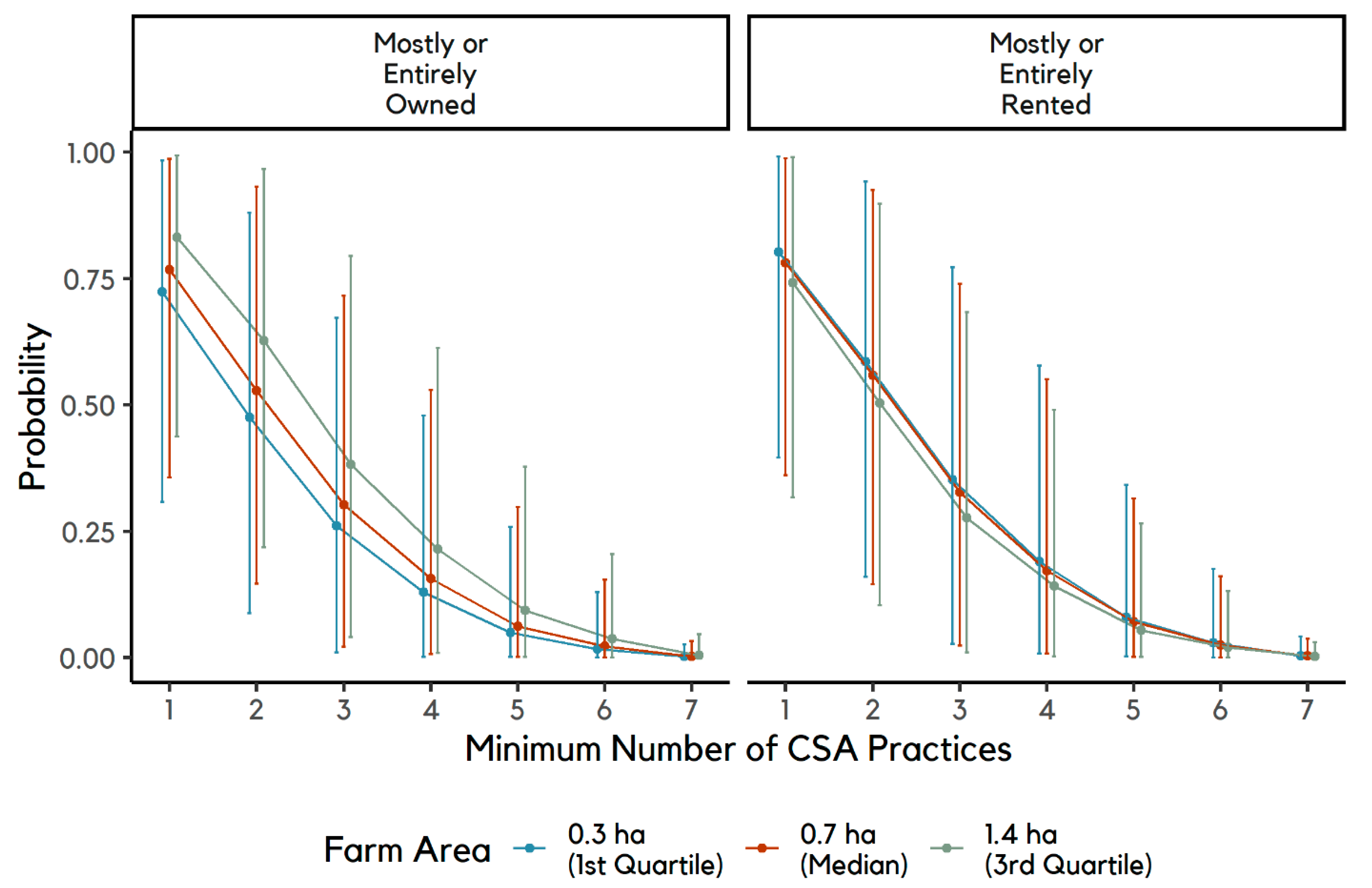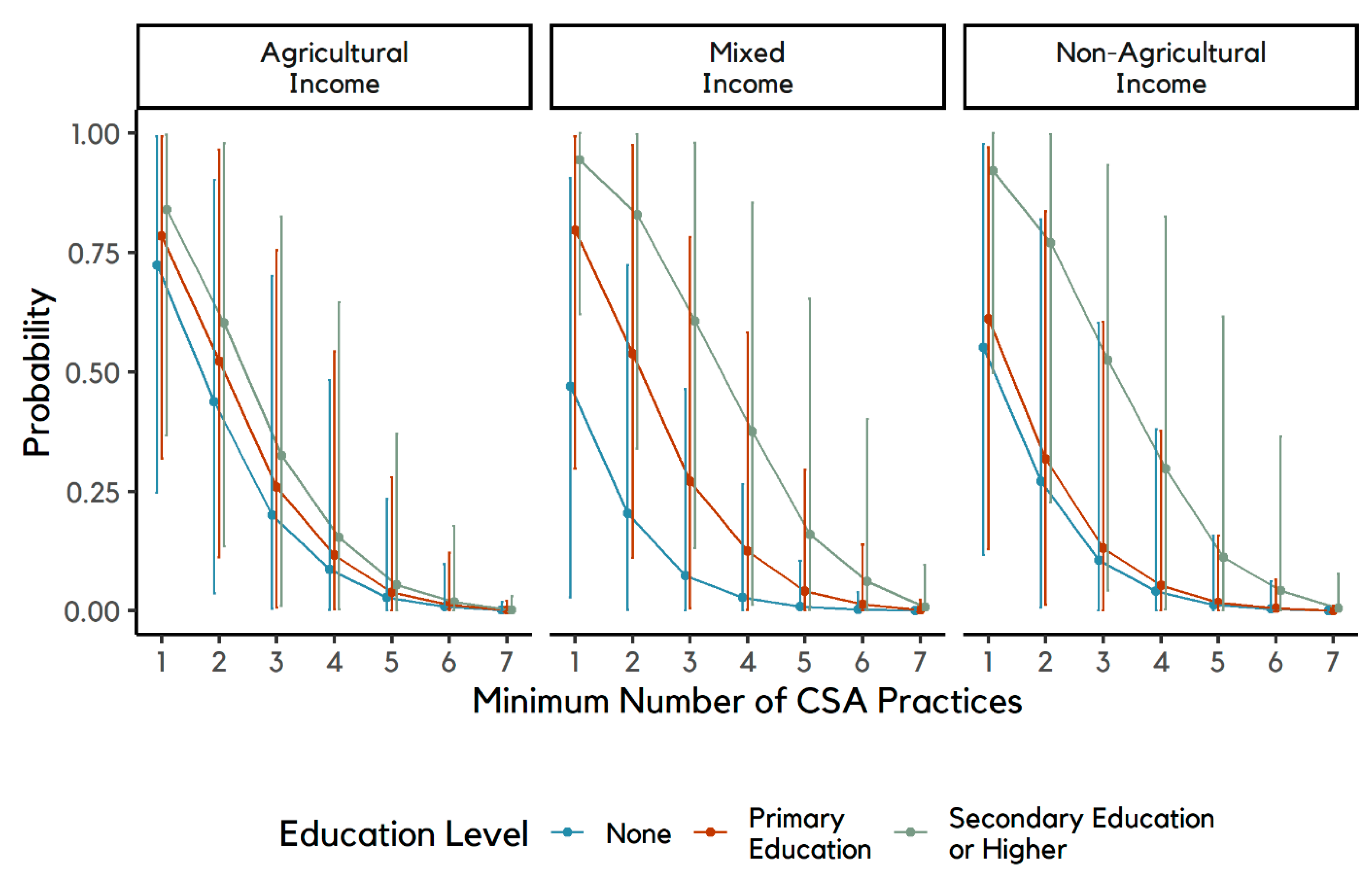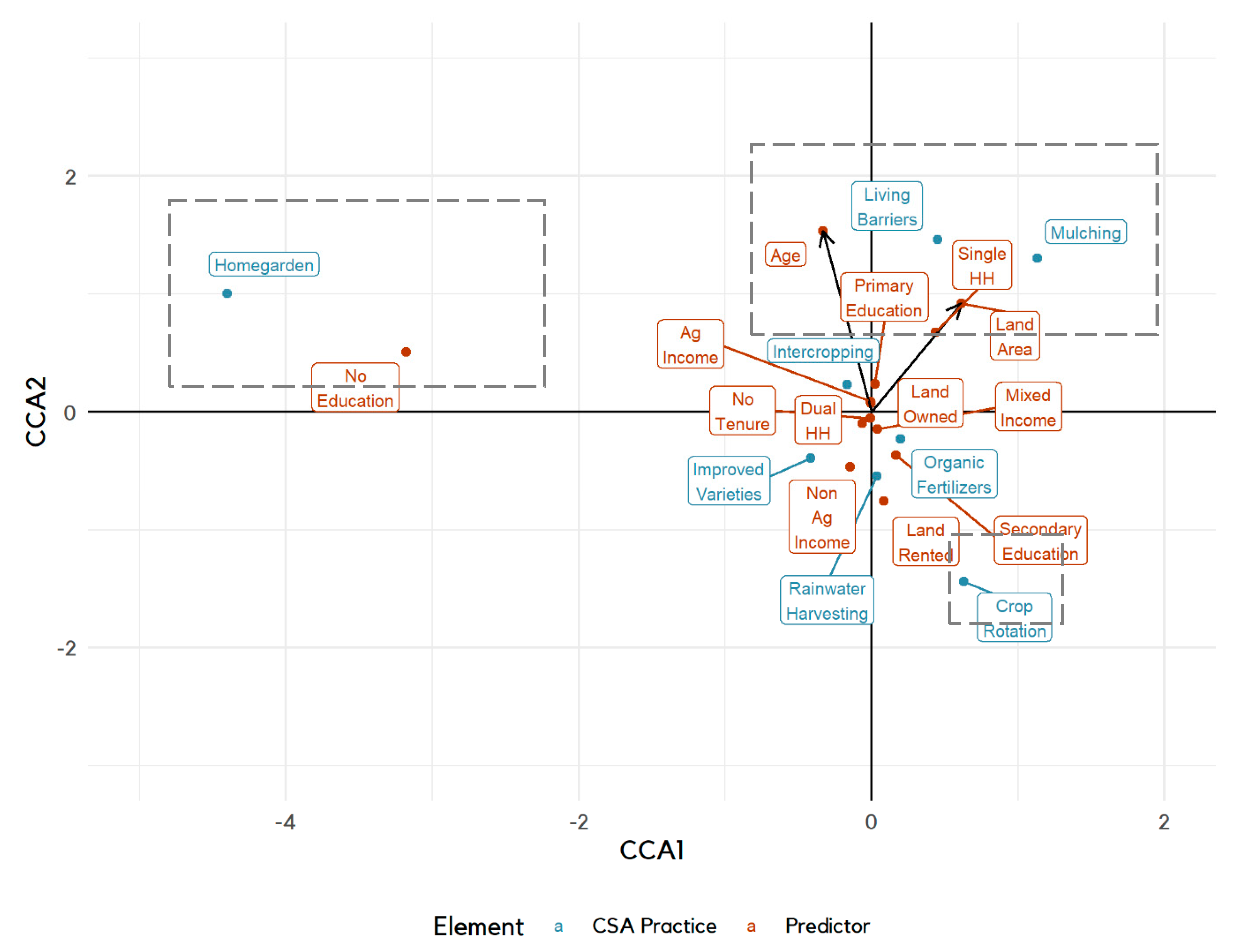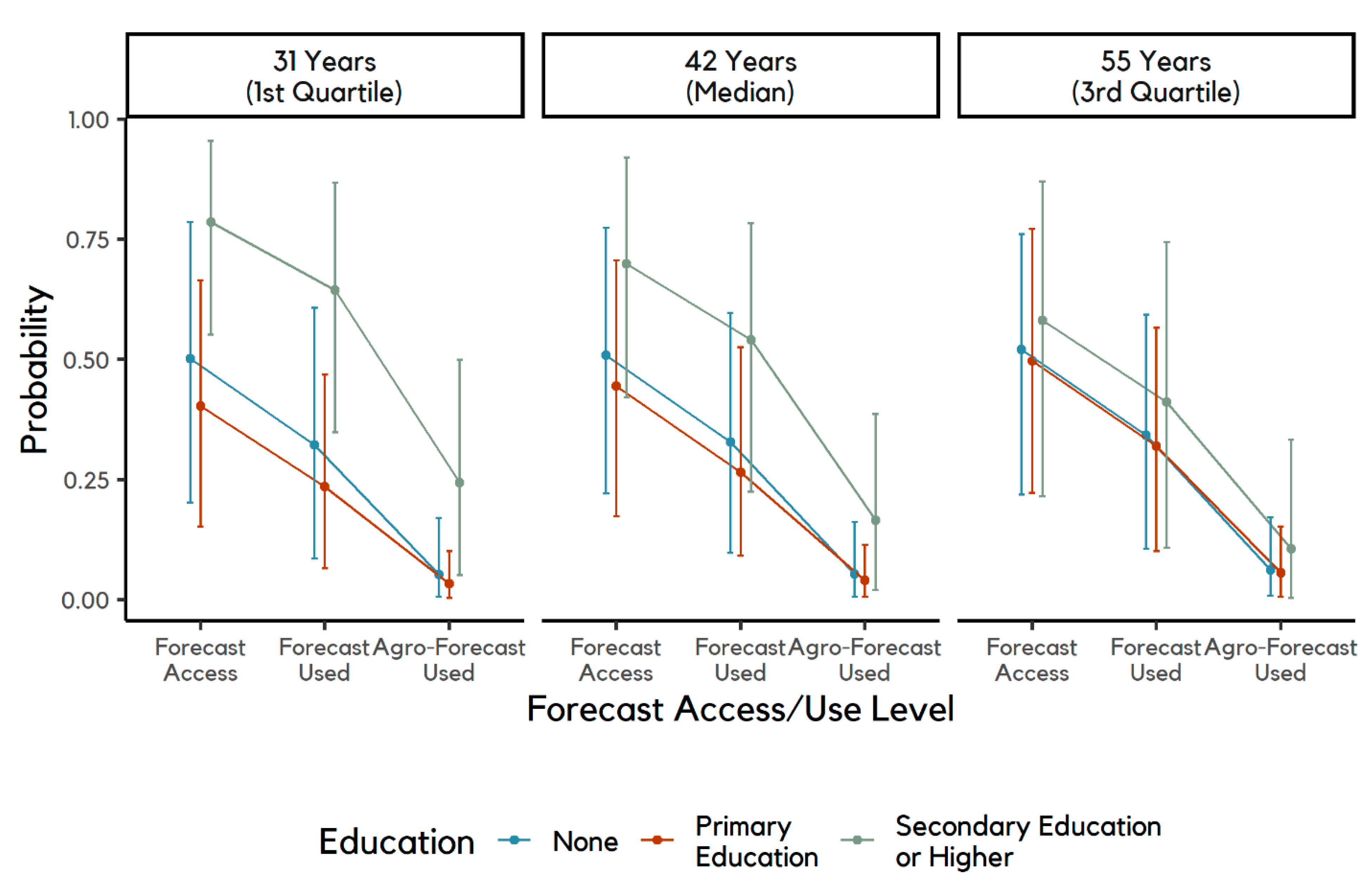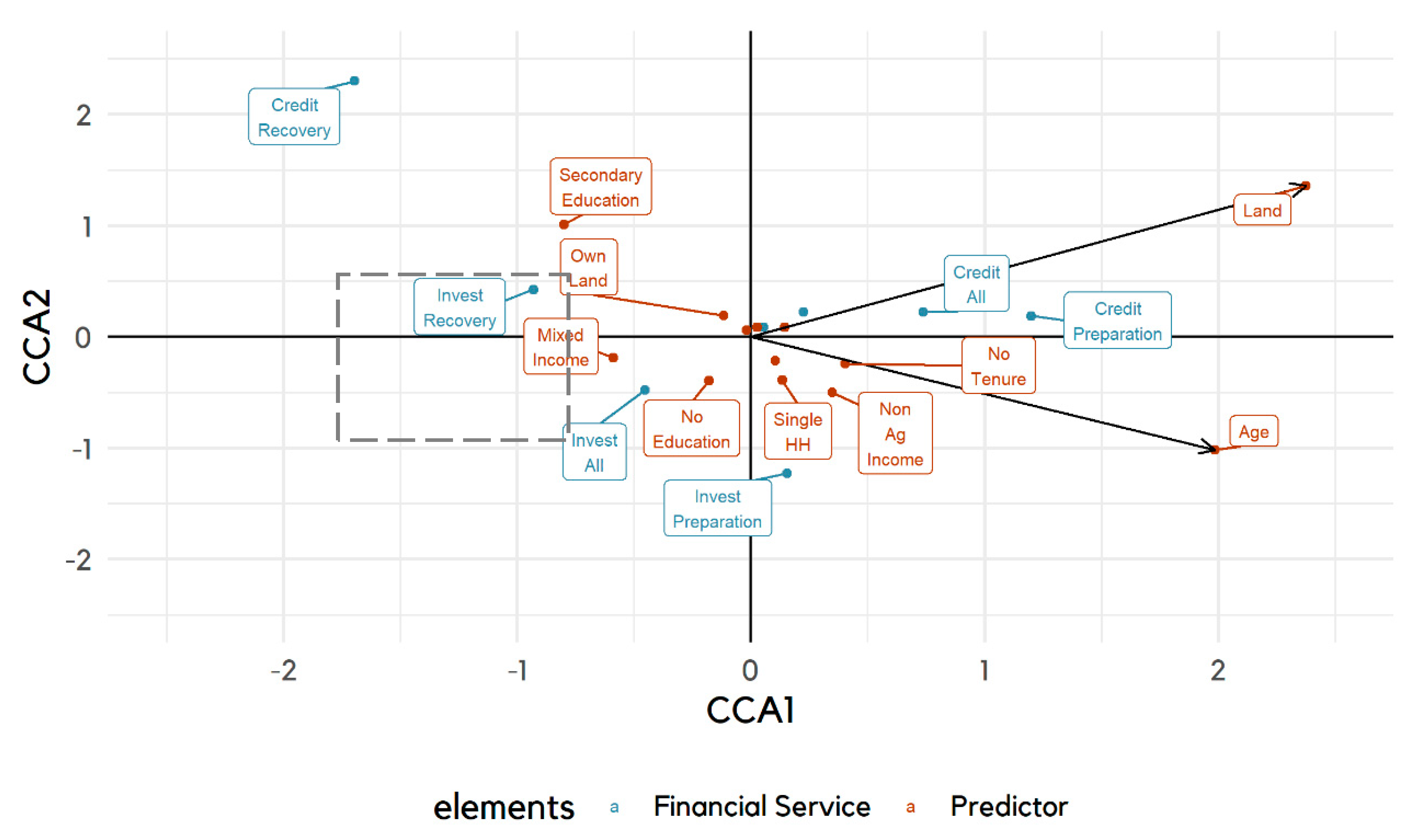1. Introduction
Despite increasing global policy efforts towards protecting the rights of rural women, and the prominent place of gender equality in the Sustainable Development Goals (SDGs), gender inequalities in the agricultural sector continue to be pervasive and are at risk of being exacerbated by the threats and constraints that climate change poses to rural populations [
1]. These gender inequalities have important consequences not only for the women themselves, but for their entire families, communities and, ultimately, for the economic development of rural areas and of nations [
2]. Policy and development initiatives that aim at addressing gender inequalities in agriculture and in climate change adaptation have, more often than not, considered women as homogenous groups whose rights needed to be brought to par with those of rural men [
3]. This has often meant “one-size-fits-all” interventions that were thought to benefit all women equally, independently from other social dimensions such as their socio-economic status, education, age, race, religion, etc.
However, promoting more equitable development in rural areas demands understanding what constraints and needs different types of women living in those areas have, so that gender equality strategies can be more targeted and effective. Development interventions that consider women as a homogenous category and do not cater for specific needs and opportunities are likely to not reach their maximum potential or may even cause unintended negative consequences for some groups of women. As such, making agricultural and climate change interventions more effective and tailored for rural women demands a deeper examination of the heterogeneity among rural women, with a conscious effort at examining the different socio-economic factors driving such heterogeneity and the interactions within them. While the importance of considering how gender intersects with other social dimensions to create different degrees of vulnerability in agricultural development and in climate change adaptation is well established in the literature, these aspects of intersectionality are rarely explored in a thorough manner in practice [
4].
In this study we aim at providing a more nuanced understanding of issues surrounding climate change adaptation processes for female smallholder farmers in selected Climate-Smart Villages of Latin America, using the case of Honduras, Guatemala, and Colombia. The share of formal female employment in agriculture in these countries varies from 6.6% in Colombia to 8.3% in Honduras and 9.8% in Guatemala, although this number is significantly larger when accounting for informal forms of female engagement in the sector [
5]. Rural livelihoods in these Latin American countries are both increasingly threatened by climate change and climate variability [
6] and face high levels of gender inequality [
7,
8,
9]. Though this research, we examine different socio-economic and demographic factors that affect women’s differentiated access to and employment of climate-smart agriculture (CSA) practices, financial, and climate information services. Specifically, we study female farmers living within the geographical limits of the ‘Climate-Smart Villages’ (CSV) located in these three countries. CSVs are sites of participatory testing and evaluation where researchers, local organizations and farmers work together to generate local evidence and draw out lessons to scale out and up CSA technical interventions (e.g., practices or services) and institutional interventions [
10]. CSA interventions are based on three pillars: (1) sustainably increasing agricultural productivity of farmers, reflected in an increase of their income, food security and development; (2) enhancing adaptive capacity and building resilience to climate change; and (3) reducing and/or removing greenhouse gas emissions from agricultural activities, where possible [
10,
11,
12].
The agricultural sector is particularly vulnerable to climate change and to climate variability [
13]. In Honduras, Guatemala, and Colombia, recent climate models of Prager et al. [
6] anticipate decreases in the suitability of cash crops such as banana (Colombia, Guatemala) and coffee (Colombia, Guatemala, Honduras), and predict increased biophysical vulnerability of staple crops such as maize (Colombia, Guatemala) and potato (Colombia). Vulnerability to climate change is especially acute for smallholder farmers in areas that predominantly practice rainfed agriculture and thus are highly dependent on weather conditions [
14]. In Central America, smallholder farmers are already facing critical challenges with climate change, including adapting to rising temperatures, unpredictable rainfall patterns and extreme weather events [
15,
16]. Social differentiation factors such as gender play an important role in determining smallholder farmers’ vulnerability and adaptive capacity to climate change [
17]. In Latin America, gender, race, ethnicity, and socioeconomic status are among the factors that are predicted to be of key importance considering the increase in the region’s vulnerability to climate change [
18].
In the Global North [
19] as in the Global South [
20], women and men have been portrayed as having gender differentiated roles, preferences, needs, and challenges that are important to consider in order to design gender-responsive interventions that help them adapt to climate change. Climate change is expected to widen the gender inequalities that already exist in the agricultural sector [
21]. These pre-existing gender inequalities in the agricultural sector include, for example, differences in the access to, and ownership of, productive assets [
22,
23], in the access to extension services and agricultural productivity [
24], and in decision-making power [
25,
26], among others. Several socio-economic factors such as social and gender norms, education and poverty levels can influence differences in vulnerabilities and adaptive capacities of male and female farmers [
27,
28,
29]. In Colombia, Guatemala and Honduras, different studies have also found gender differences in the access and use of climate information, including weather and seasonal forecast [
30]; on the willingness to invest agriculture income or credit in solutions to adapt to and mitigate the impacts of climate change and variability [
30]; on decision-making power on the adoption of climate-smart practices [
30,
31], and on the use of income generated from these practices [
31].
However, portraying women as a homogenous group and as the most vulnerable sector of the population to climate change might be misleading and not always accurate for certain geographical or cultural regions. For example, in Eastern Uganda, Balikoowa et al. [
32] found that female-headed households were more vulnerable to climate change than male headed households, while the exact opposite was found to be the case in a study conducted in different Latin America countries [
33]. However, both studies [
32,
33] only considered women living in female-headed households and did not study climate change vulnerability for the women living in male-headed households, leaving out an important part of the female population in the study regions. Climate change adaptation and climate-smart agriculture research can thus benefit from the use of intra-household data, including the implementation of intra-household surveys examining decision making and smallholder agricultural production, including the adoption of climate-smart agricultural practices (e.g., [
34]). In fact, there is the recognition that for climate-smart agricultural interventions to be sustainable and effective, they must address gender inequality and other forms of social discrimination [
12].
Women have been a considerable focus of study in climate change adaptation processes and are generally described as having a differentiated level of vulnerability to changing weather patterns, as compared to that of men [
21]. However, as already emphasized, not all women present the same level of vulnerability to climate change. The adoption of technologies that can help female smallholder farmers adapt to climate change and to improve their resilience to climate variability is also affected by a series of social factors. For example, in a study conducted in Ethiopia, Tsige et al. [
35] found that female smallholder farmers’ uptake of conservation agriculture and small-scale irrigation schemes was affected by access to credit, extension, restricted membership in cooperatives and water user associations, lack of access or user rights to land, skill training, information, and restricted mobility. Similarly, in the Philippines, Harman Parks [
36] found that the three main gendered constraints to the adoption of conservation agriculture were the lack of access to secure land tenure, capital, and training. Differences among regions, villages, or among landscapes can also account for differences in adaptation, vulnerability, or empowerment levels among women. For example, in a study in two Indian CSVs, Hariharan et al. [
37] found that overall women in the Bihar CSV had a lower degree of empowerment than women in the Haryana CSV when measured using the “Gender Empowerment Index”, which assesses men’s and women’s progress in both the use of sustainable farming practices and economic returns from agricultural enterprises as well as improvements in social and political engagement. The authors attributed that fact to the broadly lower level of empowerment among both men and women in Bihar.
The adoption of climate change adaptation options (whether practices, inputs or services) can also bring unintended negative consequences for women. For example, in a study conducted in Ethiopia, Cholo et al. [
38] found that the implementation of a larger number of sustainable land management practices increased on average the number of working hours of women, while it did not affect the working hours employed by men. To avoid agricultural development and climate change adaptation strategies that may bring unintended negative consequences for women, or for certain groups of women, more in-depth gender studies need to be conducted which include examinations of the intersections between gender and other social dimensions. Understanding intersectionality is also of paramount importance in contexts such as in Central America or Asia where climate-induced migration, which is predominantly male, is leaving women in charge of managing, on their own, the households and farms with reduced resources and labor, contributing to further widening their vulnerability [
39,
40]. Having a more nuanced picture on the challenges and needs of different categories of women could aid the design of more targeted and effective climate change adaptation strategies to help increase their resilience.
This study constitutes an examination of the intersectionalities among socio-economic and demographic factors characterizing smallholder female farmers in three CSVs in Latin America. It investigates whether interaction effects among socio-economic and demographic factors are meaningful drivers of observed differences among female farmers in their adoption of climate-smart agricultural (CSA) practices, as well as their use of climate forecasting and financial services. We employed original data from CSA monitoring surveys conducted in the three CSVs in 2019 (Colombia) and 2020 (Honduras, Guatemala) and apply ordinal logistic regression and canonical correspondence analysis as the two main methods for data analysis. Specifically, the objective of this research is to examine differences and commonalities among women in the CSVs in terms of (1) the number and type of CSA practices they employ; (2) their access to, and use of, climate information services; and (3) their access to, and use of, financial resources and services (specifically as they relate to adaptation and recovery to climate change induced shocks and stresses on farming enterprises).
In answering these questions, we pay particular attention to the interactions between these socio-economic and demographic factors. By doing so, we draw attention to the implications that such differences between different groups of women have both for the experimental design of research for development initiatives aiming at closing gender gaps in agriculture and in climate change adaptation, and for the development of more tailored policy interventions targeting specific groups of women.
The outline of the study is as follows:
Section 2 details the methodology followed, describing the study sites, and presenting the data analysis employed.
Section 3 presents the results concerning climate-smart practices, climate finance, and climate services. Finally,
Section 4 discusses the findings and
Section 5 presents the conclusion and policy implications for improved research design and policy formulation of interventions aiming at closing the gender gap in agriculture and climate change adaptation.
4. Discussion
This study has highlighted the importance of studying socio-economic factors in interaction and thus the relevance of applying intersectional lenses in climate-smart agricultural research. The study found that women’s implementation of CSA practices are positively associated with educational level and extent of cultivation, but these associations are conditional on the extent of livelihood diversification and the type of land tenure, respectively. Regarding the extent of livelihood diversification, other studies have shown that diversified livelihood strategies which include non-agricultural sources of income can support uptake of CSA and other good management practices at least in part by providing crucial operating capital for investment [
35,
61]. Both this study and previous research have also suggested that education facilitates the uptake of CSA practices and can lead to employing greater numbers of practices [
62,
63]. This study builds on such findings, and further demonstrates that socio-demographic factors such as education and agricultural land may not be sufficient, by themselves, to foster greater uptake of CSA practices among women. Correspondingly, policies or development interventions which are predicated on, or seek to leverage, either education or livelihood diversification alone would risk inefficiency and reduced effectiveness.
The positive association observed in this study between the extent of cultivation and women’s implementation of more CSA practices is consistent with women with larger farm sizes - which can be seen as a proxy for wealth - possessing more resources to invest in improved practices. That this pattern is less pronounced among those who rent compared with those who own most or all of their land is also consistent with farmers being more willing to invest in long-term land improvements when their tenure is more secure, as is suggested by a large body of theoretical and empirical work in the field of agricultural economics (e.g., [
64]). However, in this case, the effect is less pronounced and further research is clearly needed. It is also important to recognize that, given the fact that CSA practices are highly context-specific, they need to be locally adapted to each geographical and socio-economic context [
10]. As such, it may not be valid to assume that an increase in the number of CSA practices necessarily implies better outcomes in adaptive and mitigation capacity and improved productivity for women, even in instances where the suite of CSA practices being promoted has been developed in partnership with researchers and other stakeholders. Furthermore, it is important to highlight that the distribution of CSA practice adoption is also affected by, inter alia, gendered patterns in the division of labor, gendered time use patterns, and social norms, and that these are highly context-specific and might therefore change from one CSV to another [
65].
As with the case of uptake of CSA practices, increased education and extent of cultivation were seen to predict greater access to and use of climate forecasting services, along with owning most or all of one’s land. In the case of land area, no evidence was observed of an interaction between extent of cultivation and any other socio-demographic factors; this pattern is consistent among the women surveyed as a whole and can meaningfully be considered in isolation. In contrast, there is some modest evidence to suggest that greater education and land ownership are both associated with greater access, but this pattern is most pronounced among young women and increasingly less pronounced among older women. A recent review examining access to rural climate information services also identified age and literacy levels as conditioning access to and use of ICT, with younger and more literate men and women able to make greater use of such services [
66]. It is also important to highlight that the medium through which the climate forecast services are delivered (e.g., mobile phone, internet, television, radio, printed media, etc.) is itself gendered, and needs careful consideration in the design of climate-smart interventions targeting improved access to and use of climate forecast services [
67]. Furthermore, in local contexts where women’s access to and use of climate information services is sound, improved use of these services could also be driving an increase in the uptake of CSA practices (e.g., [
68]). This is a relationship that would be worth exploring in future studies.
The investigation into the uptake of specific CSA practices or combinations of practices by women found, in the case of the CSV in Guatemala, no clear association between any of the explanatory variables considered and the use of any practices. In the CSV of Honduras, the results suggest greater variation between individual communities than as a function of the socio-demographic factors included in the analysis. Finally, in the CSV of Colombia, some association was found between socio-demographic factors and the use of specific practices, for example with mulching being associated with older farmers cultivating larger land areas. Results regarding women’s access to financial resources and services found no strong associations between the socio-economic and demographic factors considered and patterns of savings, borrowing and investment, thus providing little explanatory power for the use of any of the specific resources or services.
Overall, the surveys’ limited sample sizes have partly restricted the statistical power of the analysis to discern certain interactions among socio-demographic factors that may be influencing women’s uptake of the CSA technical interventions in the CSVs of interest. Additionally, the socio-economic and demographic factors influencing these aspects that this study has uncovered, and the associations found between them, could also be further contextualized and explained with follow-up in-depth qualitative research in these areas.
Whereas studies using differences between men and women have undeniably been critical in raising awareness of the gender gap that exists in many fronts in rural development, agriculture, and climate change adaptation arenas (e.g., decision-making, access and control of productive resources, access to extension and climate services, etc.), closing these gender gaps will require a deep understanding of the needs and challenges that different groups of women face. However, identifying the needs and challenges of diverse groups of women have important research design and funding implications. Researchers will need to explicitly anticipate such potential differences among men and women as well as between them if data collection procedures which can be assured of detecting and measuring such differences are to be developed. It is crucial for researchers to make survey sample size calculations using formulae appropriate for the design and objectives of the study. For example, a study seeking to detect differences among subpopulations may require a vastly different number of respondents than is needed for a purely descriptive study [
69], and this difference can be compounded in the context of significant higher-order interactions. Statistical power analyses and careful consideration of optimum, or at least more efficient, sampling strategies will be particularly important in this regard, and confirmatory studies may also require substantially larger sample sizes than is common in routine program monitoring efforts [
70].
On the other hand, funding limitations in agricultural research for development has in practice meant that, often, the research design that would allow for the data richness needed for more tailored gender interventions has been compromised on one or several fronts. For example, gender in agriculture and climate change researchers have often needed to reach compromises in sample sizes, duration and depth of case studies, or in the ability to conduct longitudinal studies of a certain population group. The latter is critical in gender transformative research examining how discriminatory and detrimental gender norms can be influenced and changed, since changes in social norms can span long periods of time which often exceed the duration of a research or development project.
Overall, oversimplified gender analysis can lead to misleading conclusions that in turn might translate into poorly designed development programs or create difficulties in the implementation of such programs. For example, in the areas where this study was conducted, an analysis only examining main effects would have identified education as a significant factor influencing the number of CSA practices being adopted by women, but would have missed the point that education level only makes a difference among those women whose primary source of income is not agriculture.
Portrayals of women and men as homogenous groups, at least when examining gender differences in adaptive capacity in agriculture, have already widely permeated to policy spheres and to development agencies [
71]. That policy and development programs oversimplify this social-differentiated vulnerability and capacity to adapt to climate change runs the risks of providing blanket statements and overly general policy solutions that might not be adequately targeting the specific needs of different groups of men and women. This is particularly true for the Central American region, where a recent study identified that food security, agriculture and climate-smart policy interventions for gender equality remain largely unspecific, with no clear indicators to monitor progress in closing the gender gaps in agriculture and climate change adaptation [
72]. There is thus a gap in climate change adaptation agricultural research and policy design, and a more nuanced understanding of the social factors influencing or explaining farmer behaviors in climate change adaptation will be needed in the immediate future.

